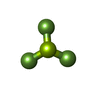+ Open data
Open data
- Basic information
Basic information
| Entry | Database: PDB / ID: 6ln8 | ||||||
|---|---|---|---|---|---|---|---|
| Title | CryoEM structure of SERCA2b T1032stop in E2-BeF3- state (class1) | ||||||
 Components Components | Sarcoplasmic/endoplasmic reticulum calcium ATPase 2 | ||||||
 Keywords Keywords | METAL TRANSPORT / cacium | ||||||
| Function / homology |  Function and homology information Function and homology informationlongitudinal sarcoplasmic reticulum / ER-nucleus signaling pathway / positive regulation of endoplasmic reticulum calcium ion concentration / P-type calcium transporter activity involved in regulation of cardiac muscle cell membrane potential / calcium ion transport from cytosol to endoplasmic reticulum / regulation of calcium ion-dependent exocytosis of neurotransmitter / calcium ion-transporting ATPase complex / T-tubule organization / regulation of cardiac muscle cell action potential involved in regulation of contraction / regulation of cardiac muscle cell membrane potential ...longitudinal sarcoplasmic reticulum / ER-nucleus signaling pathway / positive regulation of endoplasmic reticulum calcium ion concentration / P-type calcium transporter activity involved in regulation of cardiac muscle cell membrane potential / calcium ion transport from cytosol to endoplasmic reticulum / regulation of calcium ion-dependent exocytosis of neurotransmitter / calcium ion-transporting ATPase complex / T-tubule organization / regulation of cardiac muscle cell action potential involved in regulation of contraction / regulation of cardiac muscle cell membrane potential / sarcoplasmic reticulum calcium ion transport / ribbon synapse / platelet dense tubular network membrane / calcium ion import into sarcoplasmic reticulum / Pre-NOTCH Processing in Golgi / P-type Ca2+ transporter / negative regulation of heart contraction / P-type calcium transporter activity / regulation of the force of heart contraction / transition between fast and slow fiber / endoplasmic reticulum calcium ion homeostasis / cardiac muscle hypertrophy in response to stress / S100 protein binding / regulation of cardiac muscle contraction by calcium ion signaling / Reduction of cytosolic Ca++ levels / relaxation of cardiac muscle / organelle localization by membrane tethering / mitochondrion-endoplasmic reticulum membrane tethering / autophagosome membrane docking / lncRNA binding / Ion transport by P-type ATPases / autophagosome assembly / regulation of cardiac conduction / epidermis development / positive regulation of heart rate / positive regulation of cardiac muscle cell apoptotic process / Ion homeostasis / sarcoplasmic reticulum membrane / response to endoplasmic reticulum stress / sarcoplasmic reticulum / negative regulation of receptor binding / calcium ion transmembrane transport / neuron cellular homeostasis / intracellular calcium ion homeostasis / cellular response to oxidative stress / monoatomic ion transmembrane transport / transmembrane transporter binding / cell adhesion / calcium ion binding / endoplasmic reticulum membrane / enzyme binding / endoplasmic reticulum / ATP hydrolysis activity / ATP binding / membrane / plasma membrane Similarity search - Function | ||||||
| Biological species |  Homo sapiens (human) Homo sapiens (human) | ||||||
| Method | ELECTRON MICROSCOPY / single particle reconstruction / cryo EM / Resolution: 3.1 Å | ||||||
 Authors Authors | Zhang, Y. / Tsutsumi, A. / Watanabe, S. / Inaba, K. | ||||||
| Funding support |  Japan, 1items Japan, 1items
| ||||||
 Citation Citation |  Journal: Sci Adv / Year: 2020 Journal: Sci Adv / Year: 2020Title: Cryo-EM structures of SERCA2b reveal the mechanism of regulation by the luminal extension tail. Authors: Yuxia Zhang / Michio Inoue / Akihisa Tsutsumi / Satoshi Watanabe / Tomohiro Nishizawa / Kazuhiro Nagata / Masahide Kikkawa / Kenji Inaba /  Abstract: Sarco/endoplasmic reticulum Ca ATPase (SERCA) pumps Ca from the cytosol into the ER and maintains the cellular calcium homeostasis. Herein, we present cryo-electron microscopy (cryo-EM) structures of ...Sarco/endoplasmic reticulum Ca ATPase (SERCA) pumps Ca from the cytosol into the ER and maintains the cellular calcium homeostasis. Herein, we present cryo-electron microscopy (cryo-EM) structures of human SERCA2b in E1∙2Ca-adenylyl methylenediphosphonate (AMPPCP) and E2-BeF states at 2.9- and 2.8-Å resolutions, respectively. The structures revealed that the luminal extension tail (LE) characteristic of SERCA2b runs parallel to the lipid-water boundary near the luminal ends of transmembrane (TM) helices TM10 and TM7 and approaches the luminal loop flanked by TM7 and TM8. While the LE served to stabilize the cytosolic and TM domain arrangement of SERCA2b, deletion of the LE rendered the overall conformation resemble that of SERCA1a and SERCA2a and allowed multiple conformations. Thus, the LE appears to play a critical role in conformational regulation in SERCA2b, which likely explains the different kinetic properties of SERCA2b from those of other isoforms lacking the LE. | ||||||
| History |
|
- Structure visualization
Structure visualization
| Movie |
 Movie viewer Movie viewer |
|---|---|
| Structure viewer | Molecule:  Molmil Molmil Jmol/JSmol Jmol/JSmol |
- Downloads & links
Downloads & links
- Download
Download
| PDBx/mmCIF format |  6ln8.cif.gz 6ln8.cif.gz | 187.3 KB | Display |  PDBx/mmCIF format PDBx/mmCIF format |
|---|---|---|---|---|
| PDB format |  pdb6ln8.ent.gz pdb6ln8.ent.gz | 143 KB | Display |  PDB format PDB format |
| PDBx/mmJSON format |  6ln8.json.gz 6ln8.json.gz | Tree view |  PDBx/mmJSON format PDBx/mmJSON format | |
| Others |  Other downloads Other downloads |
-Validation report
| Arichive directory |  https://data.pdbj.org/pub/pdb/validation_reports/ln/6ln8 https://data.pdbj.org/pub/pdb/validation_reports/ln/6ln8 ftp://data.pdbj.org/pub/pdb/validation_reports/ln/6ln8 ftp://data.pdbj.org/pub/pdb/validation_reports/ln/6ln8 | HTTPS FTP |
|---|
-Related structure data
| Related structure data |  0927MC  0912C  0915C  0924C  0925C  0926C  0928C  6lleC  6llyC  6ln5C  6ln6C  6ln7C  6ln9C M: map data used to model this data C: citing same article ( |
|---|---|
| Similar structure data |
- Links
Links
- Assembly
Assembly
| Deposited unit | 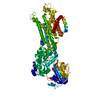
|
|---|---|
| 1 |
|
- Components
Components
| #1: Protein | Mass: 116432.453 Da / Num. of mol.: 1 Source method: isolated from a genetically manipulated source Source: (gene. exp.)  Homo sapiens (human) / Gene: ATP2A2, ATP2B / Production host: Homo sapiens (human) / Gene: ATP2A2, ATP2B / Production host:  Homo sapiens (human) / References: UniProt: P16615, P-type Ca2+ transporter Homo sapiens (human) / References: UniProt: P16615, P-type Ca2+ transporter |
|---|---|
| #2: Chemical | ChemComp-BEF / |
| #3: Chemical | ChemComp-MG / |
| Has ligand of interest | N |
-Experimental details
-Experiment
| Experiment | Method: ELECTRON MICROSCOPY |
|---|---|
| EM experiment | Aggregation state: PARTICLE / 3D reconstruction method: single particle reconstruction |
- Sample preparation
Sample preparation
| Component | Name: SERCA2b MUTATION with BEF -1 / Type: COMPLEX / Entity ID: #1 / Source: RECOMBINANT |
|---|---|
| Molecular weight | Value: 110 kDa/nm / Experimental value: NO |
| Source (natural) | Organism:  Homo sapiens (human) Homo sapiens (human) |
| Source (recombinant) | Organism:  Homo sapiens (human) Homo sapiens (human) |
| Buffer solution | pH: 7 |
| Specimen | Embedding applied: NO / Shadowing applied: NO / Staining applied: NO / Vitrification applied: YES |
| Vitrification | Cryogen name: ETHANE |
- Electron microscopy imaging
Electron microscopy imaging
| Experimental equipment |  Model: Titan Krios / Image courtesy: FEI Company |
|---|---|
| Microscopy | Model: FEI TITAN KRIOS |
| Electron gun | Electron source:  FIELD EMISSION GUN / Accelerating voltage: 300 kV / Illumination mode: OTHER FIELD EMISSION GUN / Accelerating voltage: 300 kV / Illumination mode: OTHER |
| Electron lens | Mode: BRIGHT FIELD |
| Image recording | Electron dose: 60 e/Å2 / Film or detector model: GATAN K3 BIOQUANTUM (6k x 4k) |
- Processing
Processing
| Software | Name: PHENIX / Version: 1.16_3549: / Classification: refinement | ||||||||||||||||||||||||
|---|---|---|---|---|---|---|---|---|---|---|---|---|---|---|---|---|---|---|---|---|---|---|---|---|---|
| CTF correction | Type: NONE | ||||||||||||||||||||||||
| Symmetry | Point symmetry: C1 (asymmetric) | ||||||||||||||||||||||||
| 3D reconstruction | Resolution: 3.1 Å / Resolution method: FSC 0.143 CUT-OFF / Num. of particles: 338219 / Symmetry type: POINT | ||||||||||||||||||||||||
| Refine LS restraints |
|
 Movie
Movie Controller
Controller




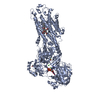
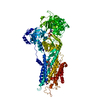


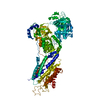
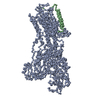


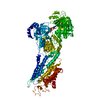
 PDBj
PDBj








